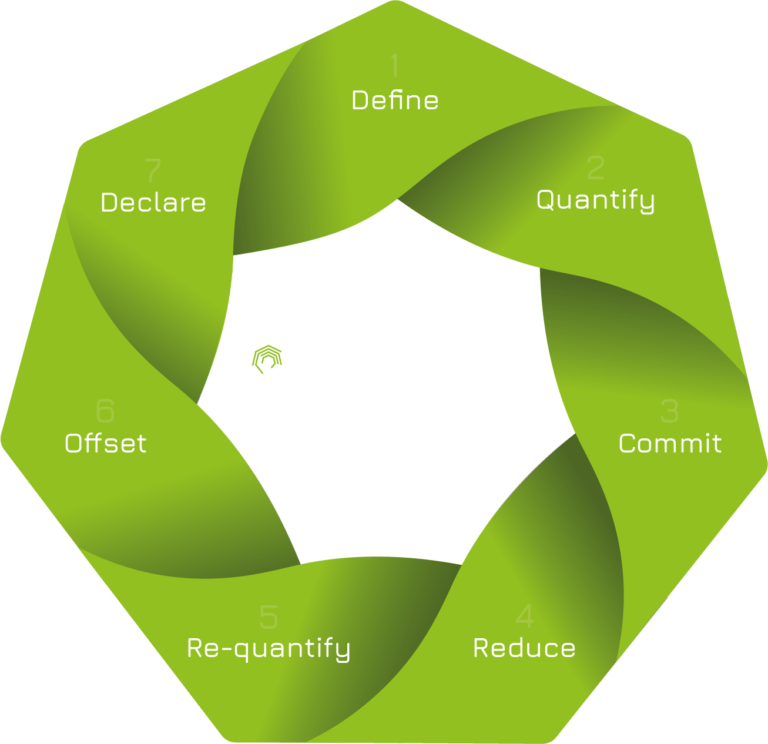Climate change is a pressing concern for businesses worldwide, necessitating the implementation of robust sustainability strategies to pave the way for a greener future. As organisations strive to lower their environmental footprint, carbon offsetting has emerged as a valuable tool in achieving carbon neutrality.
Carbon offsets allow businesses to compensate for their unavoidable greenhouse gas (GHG) emissions by investing in projects that reduce or remove an equivalent amount of carbon dioxide (CO2) from the atmosphere. Although carbon offsetting must be considered supplementary to direct emission reduction efforts, it represents a viable solution to balance a company’s environmental impact while supporting essential global climate initiatives.
To help your business harness the potential of this approach, in this comprehensive guide, we delve into the world of carbon offsetting, beginning with the advantages it offers and the various types of offset projects available. We also examine the ever-important verification and certification process, ensuring integrity, transparency, and credibility in your offsetting efforts.
Understanding the Benefits of Carbon Offsetting for Businesses
Carbon offsetting presents a range of advantages for businesses striving to reduce their environmental impact. These benefits go beyond simply compensating for emissions; they also contribute to sustainable development, corporate social responsibility, and enhanced brand reputation. Some notable benefits of carbon offsetting include:
1. Demonstrating a commitment to sustainability: By engaging in carbon offsetting projects, your business showcases its dedication to addressing climate change, reflecting a sense of responsibility towards the environment and future generations.
2. Supporting global climate initiatives: Carbon offset projects often contribute to the achievements of global climate goals, such as the United Nations Sustainable Development Goals (SDGs) or the Paris Agreement.
3. Enhancing brand reputation: Proactive investment in carbon offset projects can boost your organisation’s reputation among stakeholders, such as customers, investors, and employees, as they increasingly demand responsible and sustainable business practices.
4. Stimulating innovation: Carbon offsetting can stimulate research and development in renewable energy, energy efficiency, and low-carbon technologies, driving the transition to a sustainable, low-emission economy.
Exploring Different Types of Carbon Offset Projects
There is a diverse range of carbon offset projects, each with its own unique attributes and impact. These projects typically fall into three primary categories:
1. Renewable energy projects: These initiatives contribute to the development of renewable energy sources, such as wind, solar, and hydroelectric power, helping to reduce reliance on fossil fuels and lower GHG emissions.
2. Energy efficiency projects: This category of projects aims to increase energy efficiency through interventions like retrofitting buildings, improving industrial processes, and optimising transportation systems, ultimately leading to reduced emissions.
3. Carbon sequestration projects: Carbon sequestration involves capturing and storing atmospheric CO2 in forests, wetlands, or agricultural land, indirectly offsetting GHG emissions. These projects may focus on afforestation, reforestation, or soil carbon enhancement, providing a range of ecological benefits in addition to carbon storage.
Ensuring Verification and Certification of Carbon Offset Projects
One critical aspect of carbon offsetting is the verification and certification process, which establishes the credibility and legitimacy of offset projects. Third-party standards and registries play a vital role in ensuring project quality, transparency, and integrity.
Popular international carbon offset standards include:
1. The Verified Carbon Standard (VCS): As the world’s most widely used voluntary GHG program, the VCS provides robust criteria for verifying and certifying projects, ensuring they contribute to genuine emission reductions.
2. The Gold Standard: Developed by the World Wildlife Fund (WWF) and other NGOs, the Gold Standard applies strict guidelines and principles, focusing particularly on projects that deliver significant social and environmental benefits in addition to emission reductions.
3. The Clean Development Mechanism (CDM): Established under the Kyoto Protocol, the CDM allows emission reduction projects in developing countries to generate Certified Emission Reduction (CER) credits, promoting sustainable development and emission reductions.
Working with a trusted provider like Carbonology® can help your business navigate the verification and certification process, ensuring that carbon offsets are sourced from reputable projects aligned with high-quality standards.
Best Practices for Incorporating Carbon Offsetting into Your Sustainability Strategy
To maximise the effectiveness of carbon offsetting within your business’s sustainability strategy, it’s essential to follow best practices such as:
1. Prioritise direct emission reductions: Carbon offsetting should be considered a complementary measure to your organisation’s direct efforts in reducing emissions, such as increasing energy efficiency and adopting renewable energy sources.
2. Set clear and measurable goals: Establish quantifiable objectives for offsetting, closely monitor progress, and report results to stakeholders to maintain transparency and demonstrate commitment.
3. Engage stakeholders: Communicate the rationale behind your carbon offsetting strategy to employees, customers, and investors, fostering a united effort towards sustainability goals and enhancing your brand’s reputation.
4. Seek expert guidance: Work with expert partners like Carbonology® to develop and implement your carbon offsetting strategy, ensuring compliance with relevant regulations, standards, and trends in the sustainability landscape.
Utilising Carbon Offsetting to Achieve Carbon Neutrality Goals
Carbon offsetting offers a dynamic and valuable opportunity for businesses to address their environmental impact and work towards carbon neutrality. By understanding the benefits, exploring project types, ensuring verification and certification, and following best practices, your organisation can make informed decisions on carbon offsetting and successfully incorporate it into your broader sustainability strategy.
Partnering with Carbonology® for expert guidance and support can further bolster your organisation’s commitment to climate action and accelerate progress towards a greener future. Visit our website to explore our carbon consultancy services and more.

